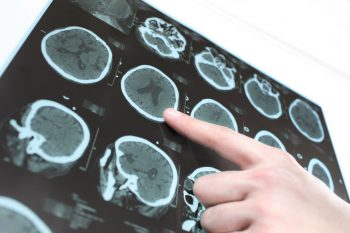By Sayer Ji
Contributing writer for Wake Up World
Taking calcium supplements — even at low doses — linked to brain lesions in the first study of its kind.
Most calcium supplements are just plain bad news. The idea of taking calcium in pill or tablet form to “keep the bones strong” just doesn’t make that much sense given, first, that we are designed to get our calcium from food. Second, our bone is a living tissue, which requires vitamin C, amino acids, magnesium, silica, vitamins D and K, etc., not to mention regular physical activity, just as much as it does calcium. Taking calcium to the exclusion of these other critical factors doesn’t make sense; nor does it make sense to look at osteoporosis or osteopenia (a misleading term) as a deficiency of calcium supplements!
As we have reported on extensively in the past, not only is consuming limestone, bone, and the shells of oysters and eggs not a good idea because the calcium can deposit in our soft tissues leading to heart attacks and strokes, but even the goal of maintaining bones as dense as a 25-year old late into life (known as the T-score) is fraught with danger, including a far higher breast cancer risk for those with the highest bone density. Instead of pathologizing aging, and focusing on making the bone denser by any means necessary, the focus should be on bone quality and agility and bodily self-awareness late into life, which helps the elderly prevent the falls that lead to fracture in the first place. In other words, simply having a gait or vision disorder can be at least as an important factor in fracture risk as bone mineral density.
[pro_ad_display_adzone id=”110028″]
The problem with poor quality, inorganic, calcium supplements, however, does not stop with their contribution to cardiovascular disease risk. A combination of factors including low magnesium, vitamin K2 and the presence of fluoride in the water and diet can lead to pineal gland calcification, as well as the calcification of other brain structures, which recently has been hypothesized to be a contributing factor in the pathogenesis of Alzheimer’s disease.
A truly provocative study on this topic published in the British Journal of Nutrition somehow slipped through the cracks, because it did not receive mainstream medical reporting at the time of its release. Titled “Elevated brain lesion volumes in older adults who use calcium supplements: a cross-sectional clinical observational study,” the study looked at the possibility that since calcium supplements have now been linked in multiple studies with vascular pathologies associated with cardiovascular disease they may also be associated with the occurrence of brain lesions (known on MRI scans as hyperintensities) in older adults. These brain lesions, visible as brighter spots in MRI scans, are known to be caused by lack of blood flow (ischemia) and subsequent neurological damage.
According to the study,
“Brain lesions, also known as hyperintensities, are areas of damage observed on brain MRI (See above). These lesions are common in older adults and increase the risk of devastating health outcomes, including depression, cognitive decline, dementia, stroke, physical disability, hip fracture and death. Postmortem studies have determined that these lesions form primarily due to ischemia, especially larger lesions (.3mm) and lesions found in depressed individuals.”
The observational study enrolled 227 older adults (60 years above) and assessed food and supplemental calcium intakes. Participants with supplemental calcium use above zero were categorized as supplement users. Lesion volumes were assessed with MRI scans.
Key findings were:
Greater lesion volumes were found among calcium supplement users than non-users
The influence of calcium supplements was of a magnitude similar to that of the influence of high blood pressure (hypertension), “a well-established risk factor for lesions.”
The study found that the amount of calcium used was not associated with lesion volume and that “even low-dose supplements, by older adults may be associated with greater lesion volumes.”
Even after controlling for food calcium intake, age, sex, race, years of education, energy intake, depression and hypertension, the association between calcium supplement and lesion volumes held strong.
The study details were summarized as follows:
“In the present cross-sectional clinical observational study, the association between Ca-containing dietary supplement use and lesion volumes was investigated in a sample of 227 older adults (60 years and above). Food and supplemental Ca intakes were assessed with the Block 1998 FFQ; participants with supplemental Ca intake above zero were categorised as supplement users. Lesion volumes were determined from cranial MRI (1.5 tesla) scans using a semi-automated technique; volumes were log-transformed because they were non-normal. ANCOVA models revealed that supplement users had greater lesion volumes than non-users, even after controlling for food Ca intake, age, sex, race, years of education, energy intake, depression and hypertension (Ca supplement use: Beta = 0.34, SE 0.10, F(1,217)= 10.98, P= 0.0011). The influence of supplemental Ca use on lesion volume was of a magnitude similar to that of the influence of hypertension, a well-established risk factor for lesions. Among the supplement users, the amount of supplemental Ca was not associated with lesion volume (Beta = – 0.000035, SE 0.00 015, F(1,139)= 0.06, P= 0.81). The present study demonstrates that the use of Ca-containing dietary supplements, even low-dose supplements, by older adults may be associated with greater lesion volumes. Evaluation of randomised controlled trials is warranted to determine whether this relationship is a causal one.”
What is the mechanism beneath this association?
The researchers discussed the already established link between calcium supplementation and increased ischemic stroke risk, indicating that calcium supplementation may contribute to calcium deposits in the vasculature (i.e. arterial calcification), mainly in the fatty deposits (atheromas) that contribute to blocking the opening (lumen) of the blood vessels. They state that this process can lead to lack of blood flow and subsequent oxygen deprivation (ischemia), ultimately leading to the development of brain lesions. Another mechanism by which excess calcium may have a direct neurotoxic effect on the brain is the influx of excess calcium into brain cells, which lead to cell death. This possibility is greatly increased if the blood-brain barrier is compromised.
The researchers also highlighted the importance of the finding that calcium supplementation may have as significant a deleterious effect on brain lesions as high blood pressure (hypertension):
“If this finding is confirmed in longitudinal studies, it could have important health implications – because it is obviously much easier to cease Ca supplement use than to medically manage hypertension.”
In other words, hypertension is often caused by toxic antihypertensive drugs that may actually increase the risk of cardiac mortality. Why not remove one of the modifiable causes: calcium supplementation, which would strike to one of the root causes of the problem and resolve it.
The researchers concluded their study as follows:
“The use of Ca[calcium]-containing dietary supplements by older adults was found to be associated with greater brain lesion volumes, even after controlling for the usual amount of dietary Ca intake. Interestingly, neither the amount of supplemental Ca nor the duration of supplemental Ca use was associated with lesion volume. These findings indicate that adverse biochemical effects of supplemental Ca use may exist in older adults, regardless of the dose.”
This is not the first study to point out this link. Another study, published in 2009 in the journal Medical Hypothesis links Alzheimer’s disease to brain calcification of structures such as the pineal gland. Learn more by reading, “A Radically New Understanding of Alzheimer’s Disease Causes and Cures.”
So, what do we do instead of taking calcium supplements?
First, consider why you think you need calcium supplements. Is it because of the dairy industry promoting for decades the concept that we need calcium (from milk)? Or, is it because your doctor is throwing around terms like osteopenia and osteoporosis carelessly, without explaining to you that the present day bone mineral density (BMD) reference ranges assume that aging is a disease and even if you are 60 or 100 for that matter you are still supposed to have the BMD of a 25-year old young woman; an absurd and dangerous idea. Please read the expose, “Osteoporosis Myth: The Dangers of High Bone Mineral Density,” in order to understand how millions of healthy women were made to believe that aging is a disease, with worse health outcomes as a result of overdiagnosis and overtreatment.
Now, when it comes to calcium, focus on food sources. The site NutritionData.com lists about 1,000 of the highest calcium-containing foods, categorized by food group: Foods highest in Calcium. Consider that kale, for instance, has higher concentrations of calcium (and far higher magnesium and silica) than milk when compared milligram per milligram. Also, remember that the accelerated bone loss that occurs later in life in women, is triggered by hormonal changes associated with the exhaustion of the ovarian reserve. Nature, however, provides ‘back up’ support for the ovaries in the form of pomegranate. Other hormone-modulating foods include the fermented soy food miso, prunes, and even vitamin C, which has recently been found to regenerate steroid hormones.
For a far more extensive research resource on bone health, you can view our page dedicated to the topic here: Bone Health.
Recommended articles by Sayer Ji:
- Brain Regeneration: Why It’s Real and How To Do It
- Research: Garlic is an Effective Natural Treatment for Heart Disease
- Wi-Fi Devices Increase Mercury Release From Dental Amalgams
- “Killer Germs” Obliterated by Medicinal Smoke Smudging, Study Reveals
- Turmeric’s ‘Smart Kill’ Properties Put Chemo & Radiation To Shame
- Beet Juice Boosts Cognitive Function In One Dose
- The Amazing Healing Properties of Apples
- 6 Bodily Tissues That Can Be Regenerated Through Nutrition
- How Turmeric Can Save the Aging Brain From Dementia and Premature Death
- Eating Wheat Feeds Disease-Causing Gut Bacteria, Study Suggests
About the author:
Sayer Ji is the founder of Greenmedinfo.com, a reviewer at the International Journal of Human Nutrition and Functional Medicine, Co-founder and CEO of Systome Biomed, Vice Chairman of the Board of the National Health Federation, and Steering Committee Member of the Global Non-GMO Foundation.
For more, visit GreenMedInfo.com and Facebook.com/GreenMedInfo, or sign up for GreenMedInfo’s free e-Newsletter.
© October 1st, 2018 GreenMedInfo LLC. This work is reproduced and distributed with the permission of GreenMedInfo LLC. Want to learn more from GreenMedInfo? Sign up for their newsletter here.
[pro_ad_display_adzone id=”110027″]









